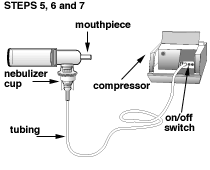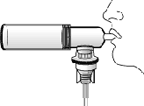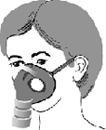A nebulizer changes liquid medicine into fine droplets (in aerosol or mist form) that are inhaled through a mouthpiece or mask. Nebulizers can be used to deliver many types of medicines. The medicines and moisture help control breathing problems like wheezing and help loosen lung secretions.
A nebulizer might be used instead of other inhalers. A nebulizer is powered by an air compressor that plugs into an electrical outlet.
 |
| Nebulisation |
What supplies do you need to use the nebulizer?
You will need the following supplies:
- Hand-held nebulizer.
- Air compressor.
- Mouthpiece or face mask.
Where should you use the nebulizer?
Use the nebulizer in a well-lighted area. Select a comfortable place in your home where you can take your treatment without being interrupted. Sit in a comfortable, straight-backed chair when taking your treatment.
Treatment procedure
- Place the compressor on a sturdy surface that will support its weight, such as a table or desk. Plug the compressor's cord into a properly grounded (three-pronged) outlet.
- Wash your hands with soap and water and dry completely with a clean towel.
- Become familiar with the nebulizer parts.
- Place your medication in the nebulizer cup.
- Attach the top portion of the nebulizer cup, and connect the mouthpiece or face mask to the cup.
- Connect the tubing to the nebulizer and compressor.
- Turn on the compressor with the on/off switch. Once you turn on the compressor, you should see a light mist.
- Sit up straight on a comfortable chair.
- Using a mouthpiece is preferred. When using a mouthpiece, place the mouthpiece between your teeth and seal your lips around it.
If you are using a mask, position it comfortably and securely on your face. - Breathe normally through your mouth. If possible, every fifth breath, take a slow deep breath and hold this breath for 2 to 3 seconds before breathing out. This allows the medication to settle into the airways.
- Continue the treatment until the medication is gone (about 5 to 15 minutes). Use all of the medicine unless you are directed otherwise by your doctor.
- If you become dizzy, slow your breathing or rest briefly. Some medicine may make you feel "jittery" or "shaky." This is not uncommon, but if these symptoms continue to bother you, inform your healthcare provider.
- Turn off the compressor.
- Wash your hands with warm water and soap. Dry them with a clean towel.
Care of nebulizer
Cleaning and disinfecting your equipment is simple, yet very important. After each treatment, rinse the nebulizer cup with warm water. Shake off excess water and let it air dry.
At the end of each day, the nebulizer cup, mask, or mouthpiece should be washed in warm, soapy water using a mild detergent. Rinse thoroughly, and allow to air dry. Note: There is no need to clean the tubing that connects the nebulizer to the air compressor.
Disinfect your nebulizer once per week or more frequently as directed. After washing your equipment, disinfect the nebulizer with one of the following methods.
Disposable nebulizers should use one of these cold disinfecting methods:
- Soak in 70% isopropyl alcohol for 5 minutes.
- Soak in 3% hydrogen peroxide for 30 minutes.
- Soak in a one-part white vinegar to 3-part water solution for 30 minutes.
After any of these cold disinfecting techniques, rinse well and air dry.
Non-disposable nebulizers may be disinfected as described above. They may also be disinfected by any of the following heat disinfecting methods:
- Boil for 5 minutes.
- Microwave in a bowl of water for 5 minutes.
- Put in the dishwasher at 158 degrees Fahrenheit for 30 minutes.
- Use an electric steam sterilizer (baby bottle sterilizer).
Medicine storage
Store all of your medicines in a cool, dry place, and follow the manufacturer’s recommendations.
Check your medicines often. Make sure they have not changed color or formed crystals. If you notice any changes in the appearance of your medicines, throw them away.
Compressor care
- Make sure that your unit is unplugged before you clean it. Keep your air compressor clean by wiping it with a clean damp cloth as needed.
- Do not put the air compressor on the floor during your treatments or while storing.
- Check the air compressor’s filter as directed. Replace or clean or clean the filter according to the directions from your equipment supplier.
- Always have an extra nebulizer cup and mask or mouthpiece.
- You can obtain all of the equipment for your nebulizer therapy through your equipment supplier






0 Comments